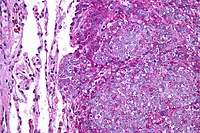
Photo from wikipedia
There is a paucity of population‐based data detailing the incidence and survival of patients with soft tissue sarcoma (STS), in part due to the heterogeneity of disease and changes to… Click to show full abstract
There is a paucity of population‐based data detailing the incidence and survival of patients with soft tissue sarcoma (STS), in part due to the heterogeneity of disease and changes to classification. Here, the incidence and survival of all STS subtypes registered in England between 2013 and 2017 were analysed using cancer registry data held by the National Cancer Registration and Analysis Service. Age‐standardised incidence rates were calculated per 1 000 000 using the 2013 European Standard Population. Net survival was computed using Brenner's alternative method, with the Ederer II estimator. Age‐specific overall survival was assessed using Kaplan‐Meier. The influence of age, sex, socioeconomic deprivation and diagnostic routes on survival was assessed using Cox proportional hazards modelling. In total, 19 717 patients were diagnosed with STS, an average of 3943 patients per year and representing approximately 0.8% of malignancies. The most common histological diagnoses were Gastrointestinal Stromal Tumours (GIST), leiomyosarcoma and undifferentiated sarcoma, accounting for 20.2%, 13.3% and 12.7% of all sarcomas, respectively. Five‐year net survival for all malignant STS was 65.0%; and was lowest for patients with vascular tumours at 39%. Patients from most deprived cohorts had 23% greater chance of dying within 5 years than patients in least deprived areas. This population‐based study has allowed us for the first time to define the incidence and survival rates of prevalent STS subtypes in England such as GIST, liposarcoma and leiomyosarcoma, as well as rare entities and groups with inferior outcome. This data is invaluable for service provision, benchmarking and addressing inequality.
Journal Title: International Journal of Cancer
Year Published: 2022
Link to full text (if available)
Share on Social Media: Sign Up to like & get
recommendations!